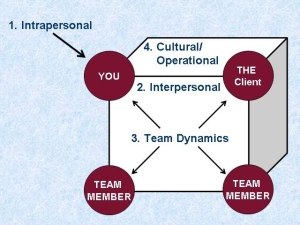This is the second in a series of twelve blogs that provide insight and tips on managing client relationships. In this blog, we’ll discuss issues and solutions associated with the Four Dimensions of Relationship Management.
The Four Dimensions of Relationship Management
To truly excel at satisfying client needs, you must be aware of and involved in the four dimensions of relationship management. These dimensions are:
- Intrapersonal
- Interpersonal
- Team Dynamics
- Cultural/Operational
We will explain each of the four dimensions of Relationship Management separately in the next blog. We can artificially delineate and define them for discussion purposes, but we cannot isolate them in the real world of relationships. Each dimension is constantly impacting and influencing the other dimensions – they are all interdependent on each other.
Consider the dynamics of a baseball team, with you as the left fielder.
You’re the One
Intrapersonally speaking, you are responsible for development of your athletic skills and your attitude relative to the game. And although these traits are specific to you and you alone, they can impact other aspects of the game. For example, if you are faster than the right fielder, the pitcher may throw pitches to intentionally draw fly balls to your field, feeling you are more likely to make the outs. In addition, if you demonstrate an energetic and contagious attitude for winning, the coach may play you despite the fact you have a lower batting average than the other left fielders, due to the positive impact you have on team morale.
It Takes Two
Have you ever seen two fielders collide as they chase a long fly ball? Their lack of interpersonal familiarity or communication results in a base hit for the opponent, and has a negative impact for the entire team. Even though the rest of the team is powerless to influence the outcome of this two-player event, they are nonetheless all affected by it.
What a Play!
Have you ever seen a triple play? It is that rare but exciting collaboration when several players act as if they were technically choreographed to execute the play. It calls for acute awareness and anticipation of where your teammates will be, as well as your role in pulling off a perfectly coordinated team play. Though non-verbal, this is a true demonstration of putting relationships to work at solving a problem.
The Powerful Intangibles
And finally, why is home field advantage such a powerful aspect of team competition? It is a cultural issue. The home team is familiar with the idiosyncrasies of their field, used to the climate, comfortable in their own clubhouse, and certainly pumped up by the crowd. They ‘know the ropes’, the vendors, the reporters, and the die-hard fans. And given the feeling of belonging, they can focus on their performance.
So, from individual ability to the emotion of hometown cheers, team success is a constant integration of intrapersonal, interpersonal, team and cultural factors. Your relationships with yourself, a peer, your group, and your environment can work for or against your project success.

Leave a comment